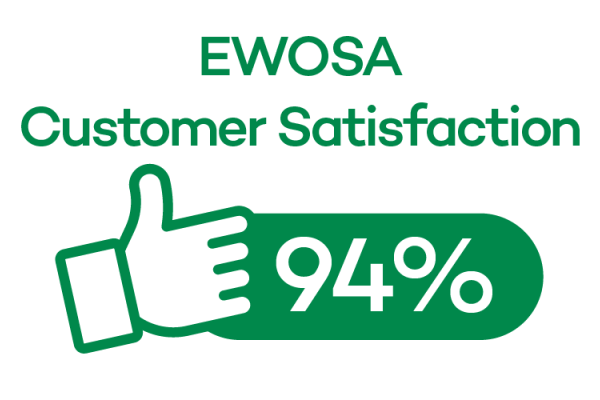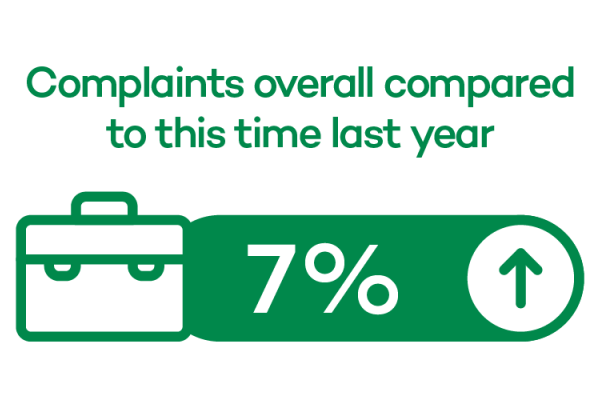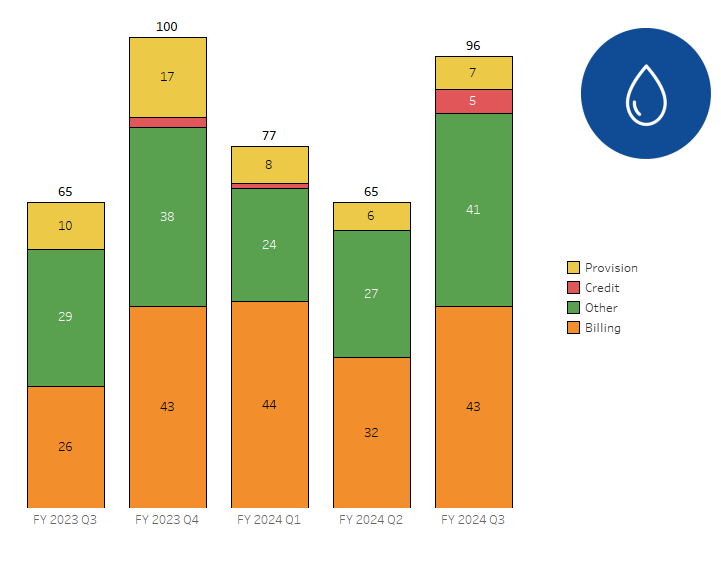EWOSA News - April 2024

- Home
- EWOSA News - April 2024
Welcome to the latest edition of the Energy and Water Ombudsman SA (EWOSA) quarterly newsletter: your one stop shop for emerging consumer trends, hot issues and policy matters.
On this page
From the Ombudsman
Welcome to our April newsletter. I would like to introduce EWOSA’s new independent Chair, Greg May, who was appointed on 23 March. He replaces Peter Bicknell, who filled the role with distinction for nine years.
Greg is a prominent Adelaide lawyer who also served as South Australia’s first Legal Profession Conduct Commissioner from 2014 to 2022. I look forward to working with him.
We received 1,660 complaints in the January to March 2024 quarter, which is 7% more than the same quarter last year.
High energy and water bills are the cause of most complaints and enquiries we receive. There were 476 high bill complaints in the latest quarter, a 12% increase on the same quarter last year.
High bills can be caused by a variety of factors. These include higher energy or water use, underpayment of previous bills, estimated meter reads, old or inefficient appliances, incorrectly applied tariffs and unexpected fees or charges.
Another reason for high bills is that energy and water prices have increased.
However, there is some good news, with the likelihood that electricity prices will fall from July.
In its latest Draft Determination for the Default Market Offer, the Australian Energy Regulator (AER) has proposed small price reductions. You can read more about this in our Hot Issues section.
If you are struggling with paying your energy bills, it is important to contact your retailer to see if they have a better offer. Alternatively, you can search energy market offers across the full range of retailers by going to the AER’s Energy Made Easy comparator website at https://www.energymadeeasy.gov.au/
You can also contact your retailer to ask to go onto a payment plan and/or join a hardship program. As well as check to see if you are entitled to any government concessions. You can read more about what to do in the Customer Corner section of the newsletter.
We are here to help if you are unable to resolve a matter with your provider or need some information. Please contact us on 1800 665 565 or via our website if you need assistance.
Sandy Canale
Energy and Water Ombudsman SA
Consumer Trends 1


Hot Topics
On 19 March, the Australian Energy Regulator (AER) released its Draft Determination for the Default Market Offer (DMO) electricity price to apply from 1 July 2024 to 30 June 2025.
The DMO price provides a cap on the electricity price a retailer can charge customers on a standing offer contract, while also serving as a comparator for market offers from electricity retailers.
In South Australia, the DMO price is proposed to decline by between 0.5% and 2.5% for residential customers and by 8.2% for small business customers.
The proposed reduction reflects lower wholesale electricity prices on the National Electricity Market, compared to 2022, along with Ministerial requests for the AER to prioritise the protection of customers from unjustifiably high prices, as result of cost-of-living pressures.
The final decision on the DMO electricity price is due in May.
To read the Draft Determination, you can visit https://www.aer.gov.au/news/articles/news-releases/default-market-offer-dmo-2024-25-draft-determination
The AER released an Issues Paper on SA Power Networks (SAPN) Regulatory Proposal on March 26.
The Proposal outlines SAPN’s planned expenditure and services during 2025-30, the revenue required to provide them, the proposed customer price outcomes and tariff structures.
In a submission to SAPN on their Draft Regulatory Proposal in August 2023, EWOSA made two recommendations that have since been included in the Regulatory Proposal: the development of a Vulnerable Customer Assistance Program and a claims scheme for damages caused by network-related incidents.
Submissions on the AER’s Issues Paper are due on May 15 and EWOSA intends to respond.
You can read the Issues Paper and make a submission at https://www.aer.gov.au/documents/aer-issues-paper-sa-power-networks-2025-30-dx-determination-march-2024.
You can also read more about SAPN’s Regulatory Proposal by visiting https://www.talkingpower.com.au/proposal
Smart meters can provide benefits for electricity customers, including better visibility of their energy use patterns, better understanding of their bills, the ability to change energy use patterns to reduce their bills and accessing a wider range of electricity market offers from retailers.
On 4 April, the Australian Energy Market Commission released a Draft Determination on Accelerating Smart Meter Deployment. It outlines a number of proposed reforms to speed up the deployment of smart meters, including:
- reducing installation barriers
- protecting consumers from upfront charges and exit fees for new meters
- ensuring customers can access the full range of benefits smart meters provide
- building social licence for the acceleration program
- improving meter testing and inspections
- providing distribution network service providers with better access to data.
Submissions on the Draft Determination are due on 30 May and EWOSA intends to respond.
To read the Draft Determination and provide a submission, you can visit https://www.aemc.gov.au/rule-changes/accelerating-smart-meter-deployment
Consumer Trends 2


Case Studies
The Issue
Mr T suspected he had been overcharged for electricity since 2022 when his quarterly bill increased by over 30%. He phoned his provider, who checked the bills and meter readings but said it believed the bills were correct.
A year later Mr T received a bill for $2,700 – another 30% increase. He accepted a higher bill because of increased winter usage, but not that high. He again phoned his provider, who offered to test his meter at his cost, with the fee to be refunded if the meter was faulty.
The provider requested payment of $350 per week towards the account balance which had increased to $3,100 – an amount Mr T could not afford.
He contacted EWOSA, dissatisfied with having to pay for the meter test and with the payment plan offered.
Our Review
We spoke with the provider who agreed to test Mr T’s meter at no cost to him and consider a payment plan once the investigation concluded.
The meter was found to be faulty as it was operating 3% fast. It was scheduled to be replaced for further testing, but as the house was due to be demolished this did not occur. It will be removed when the electricity supply is abolished as part of the demolition.
Resolution
The provider calculated a credit of $1,000, which represents the meter being 3% fast during the 12 years that Mr T had the account. It also applied a $500 credit in recognition of several failed attempts to replace the meter.
The provider established a new payment plan for Mr T based on the reduced account balance in line with what he could afford to pay.
The Issue
The gas meter at Miss K’s supermarket was not read for nine months because a locked door prohibited access.
She requested a final read three months after the supermarket stopped operating, but again access was not possible. The provider sent an estimated final bill based on previous actual gas usage at the supermarket.
Miss K disputed the bill, claiming the supermarket had minimal gas use after it closed so the estimate was based on incorrect data. The provider refused to reduce the bill on the basis that access to the meter was not provided to obtain a final read.
Miss K raised a concern that the suburb address listed on the bill was not the suburb of the supermarket but was the suburb on the other side of the main road. On this basis she was concerned that the bill might be for the wrong meter.
While Miss K was disputing the final bill, the gas meter was removed as it had reached the end of its life. A final read was taken from the removed meter.
Our Review
We requested from the provider details of the read taken when the meter was removed and asked the gas distributor to verify the location of the new meter to see if it was the location of the removed meter that supplied the supermarket.
The provider was able to supply us with the reading obtained from the removed meter and the gas distributor verified that the removed meter did supply gas to Miss K’s supermarket and the suburb had been listed wrong on the bill.
Resolution
The provider rebilled Miss K based on the actual read taken which reduced the bill by $1,000.
As the meter read was obtained six weeks after the supermarket account was closed, the provider waived the final bill of $890 in full as a gesture of goodwill.
Consumer Trends 3


Customer Corner - High bills are a concern for many households. If you are struggling to pay your bills, there are a few places you can go to receive support.
Energy retailers are required to have a Customer Hardship Policy in place. You can contact your electricity and/or gas retailer to be placed on their hardship program and/or receive a payment plan.
A payment plan will allow you to pay smaller amounts off your bills at a frequency more suitable for your budget, such as weekly, fortnightly or monthly.
An energy retailer’s hardship program may also include advice about how to reduce your bills by using energy more efficiently, Centrepay payment options and informing customers of concessions, rebates and financial counselling services.
SA Water also offers help to people struggling to pay their water and sewerage bills. Their Payment Assistance Program can provide you with a payment plan, Centrepay payment options, plumbing help and tips on water efficiency.
You can find out more about SA Water’s Payment Assistance Plan by visiting https://www.sawater.com.au/my-account/my-bill/help-paying-my-bill, calling 08 7424 1650 or emailing customerassist@sawater.com.au
You might also be able to access concessions from the State Government for your energy and water bills.
Concession card holders are entitled to energy bill benefits of up to $263.15 for 2023-24 from the South Australian Government. Concessions also are available if you require medical heating and cooling at home, are undergoing dialysis treatment at home or live in a residential caravan park. For more information, go to https://www.sa.gov.au/topics/care-and-support/concessions/household-concessions/energy-bill-concessions
In last year’s Budget, the State Government also provided additional support of $500 for residential concession-card holders and $650 for small businesses (that consume less than 160 MWh of electricity per year). These payments are split into four equal parts over the 2023-24 financial year. For more information, go to https://www.sa.gov.au/topics/care-and-support/concessions/household-concessions/energy-bill-relief
The South Australian Government also has a water and sewerage rate concession for eligible concession-card holders and Centrelink payment recipients. There is no fixed amount for the concession, as it depends on the size of your bill, but there are maximum and minimum thresholds applied. For more information, follow this link: https://www.sa.gov.au/topics/care-and-support/concessions/household-concessions/water-and-sewerage-rate-concession
Public Submissions
Consumer Trends 4

The number of complaints per 10,000 customers for each supplier is calculated by dividing the number of complaints received during the quarter by the total number of customers for each supplier, multiplied by 10,000. Large Suppliers are those with over 100,000 customers, Medium-sized Suppliers have between 10,000 and 100,000 customers, Small Suppliers have between 1,000 and 10,000 customers and Very Small Suppliers have less than 1,000 customers. The total number of complaints is also presented for context.



Remember, we are here to help
EWOSA facilitates the prompt resolution of complaints and disputes between consumers of electricity, gas and water services and Members of the Scheme by providing a service to consumers which is free, independent, accessible, fair and informal.
Freecall 1800 665 565
SMS 0488 854 555